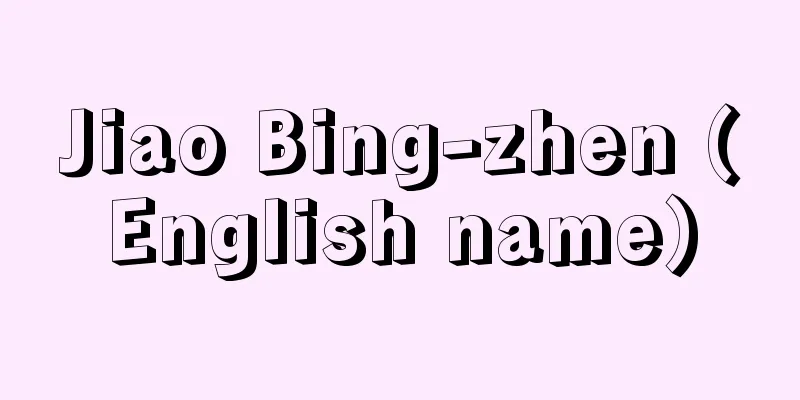East

[1] [noun] (a variation of "himukashi, higashi (east)") 1. The name of a direction. The direction in which the sun rises. Opposite of west. In the Chinese zodiac, it corresponds to the rabbit. hi - gashi. ※Kaido-ki (c. 1223), prologue: "Crossing the Seta Bridge to the east." ※Haiku poem, Zoku Mei-garasu (1776), spring: "Rape blossoms, the moon in the east, the sun in the west (Buson). Far from the mountains, a heron wanders by in a hazy manner (Cho-ra)." 2. The wind that blows from the east. East wind. Kochi. ※Sarashina Nikki (c. 1059), "The sunflowers of the tallow tree that I have stretched out to meet me, <abbreviated> When the wind blows west, they flutter eastward, and when the wind blows east, they flutter westward." 3. A country located east of India and China. In other words, Japan. ※Yomihon, Tsubakisetsu Yumiharizuki (1807-11), Zan: "After he threw himself down, he bowed to the east several times." ④ Refers to Kamakura or Edo, as opposed to Kyoto or Osaka. ※Zappai, Kezukake (1713), "Even if he is thrown eastward, he is still alive." ⑤ The right side of the rankings in sumo and other sports. It is considered to be higher than the west. ※Toraakihon Kyogen, Tokkotsu (late Muromachi period - early modern period), "Later, when he became a great ozumafu, a small man came out from the east." ⑥ In the Kabuki theater, the right side of the stage in Edo, and the left side in Kyoto and Osaka. ※Kabuki, Meika, Tokusamasu Tamagaki (1801), Sanrits: "In the east, it is called, 'Kaneyu's Vice Minister's Master's Visit.'" ⑦ The name of the Toyotake school of Gidayubushi. It is used in contrast to the Takemoto school, which is called the west. *From the comic book Ukiyo-buro (1809-13), "The members of Toyotake Echizen no Jō, Wakatayu, Teitayu, and Komatayu are called the East." [2][1] Refers to the pleasure quarters of Edo and Fukagawa (as opposed to Yoshiwara to the north of Edo Castle, Shinagawa to the south, and Shinjuku to the west). [2] Refers to the Shijo area east of the Kamogawa River in Kyoto. There are many places of entertainment for both men and women. [3] Refers to Higashi Hongan-ji Temple, or the Higashi Hongan-ji school, as opposed to Nishi Hongan-ji Temple. [4] One of the administrative districts of Sapporo City, Hokkaido. It occupies the northeastern part of the city. There are factories for railroad cars, beer, and other products, and Sapporo (Okadama) Airport is located at the northern end. It was established in 1972. [5] One of the administrative districts of Nagoya City, Aichi Prefecture. It occupies the eastern part of the center of Nagoya City. It is home to the Tokugawa Art Museum. It was established in 1908. [6] A former ward of Osaka City. Established in 1889. Merged with Minami Ward in 1989 to form Chuo Ward. [7] One of the administrative districts of Hiroshima City. Located slightly east of the center of the city. Established in 1980. [ 8] One of the administrative districts of Fukuoka City. Located in the eastern part of Fukuoka City, it includes the area facing Hakata Bay east of the mouth of the Ishido River (Mikasa River), as well as Umi no Nakamichi and Shika Island at its tip. Established in 1972 .East(2) Because examples of writing in Man'yōgana cannot be found going back further than the aforementioned "Twenty Volumes of the Wamyoshō," the grade of "hi" in the special kana spelling of ancient times is unknown. The second syllable is the archaic form of "mu." The clear and voiced third syllable is also unknown, but in the "Kanchiin Honmyōgishō," there are both versions with and without a voiced consonant mark. (3) According to the etymology theory in the Kojikiden, the old form was a hiko group with a clear third syllable. The shi is thought to be the shi in words like west and storm. This shi has the meaning of wind, which means that it was originally a word representing the east wind. An example is the east in the Sarashina Nikki, "When the west blows, it flutters to the east; when the east blows, it flutters to the west," but the form is unknown because it is written in kanji. (4) Himukashi is presumed to have changed from hingashi, which was changed to higashi during the Middle Ages. The Todaiji Yoroku, Vol. 2, Chapter 3 of the Kuyo section, gives the example of hi-mika-no- (himika-shi) . This is too early for a variant notation of the glottal stop, so it is appropriate to consider it an example of corruption. Tou [East]Tou [East]Once upon a time [East]Source: The Selected Edition of the Japanese Language Dictionary About the Selected Edition of the Japanese Language Dictionary Information |
[1] 〘名〙 (「ひむかし・ひんがし(東)」の変化した語)① 方角の名。日の出る方向。西の対。十二支では卯(う)をあてる。ひんがし。※海道記(1223頃)序「勢多の橋を東に渡れば」※俳諧・続明烏(1776)春「菜の花や月は東に日は西に〈蕪村〉 山もと遠く鷺かすみ行〈樗良〉」② 東方から吹いてくる風。東風。こち。※更級日記(1059頃)「さし渡したるひたえのひさごの、〈略〉西ふけば東になびき、東ふけば西になびくを見て」③ インドや中国からみて東方にある国。すなわち、日本。※読本・椿説弓張月(1807‐11)残「身を投ふして数回、東(ヒガシ)のかたを拝し給へば」④ 京都、大坂に対して、鎌倉や、江戸をさしていう。※雑俳・削かけ(1713)「さすがじゃはまつはひがしへながれても」⑤ 相撲などの番付で、右側の称。「西」より上位とされる。※虎明本狂言・飛越(室町末‐近世初)「後には大ずまふになった所で、ひがしのかたから、ちひさひおとこが出て」⑥ 歌舞伎劇場で、江戸では舞台に向かって右側、京坂では左側の称。※歌舞伎・名歌徳三舛玉垣(1801)三立「又東に而『勘解由の次官師方参向』と呼ぶ」⑦ 義太夫節の豊竹派の称。竹本派を「西」というのに対していう。※滑稽本・浮世風呂(1809‐13)前「豊竹越前掾の方、若太夫・梺太夫・駒太夫のたぐひを東といふ」[2][一] (江戸城の北の吉原、南の品川、西の新宿に対して) 江戸、深川の遊里をいう。[二] 京都賀茂川の東、四条辺をいう。男色、女色の遊所が多い。[三] 西本願寺に対する東本願寺、また、東本願寺派のこと。[四] 北海道札幌市の行政区の一つ。札幌市の東北部を占める。鉄道車両・ビールなどの工場があり、北端に札幌(丘珠)空港がある。昭和四七年(一九七二)成立。[五] 愛知県名古屋市の行政区の一つ。名古屋市の中心部の東側を占める。徳川美術館がある。明治四一年(一九〇八)成立。[六] 大阪市の旧区。明治二二年(一八八九)成立。平成元年(一九八九)南区と合併して中央区となる。[七] 広島市の行政区の一つ。市の中央部やや東寄りに位置する。昭和五五年(一九八〇)成立。[八] 福岡市の行政区の一つ。福岡市の東部にあり、石堂川(御笠川)河口以東の博多湾に面する地域および海の中道とその先端の志賀島を含む。昭和四七年(一九七二)成立。
ひんがし【東】(2)万葉仮名による表記例は先述の「二十巻本和名抄」よりさかのぼれないため、上代特殊仮名遣におけるヒの甲乙は不明。第二音節はムが古形。第三音節の清濁も不明であるが、「観智院本名義抄」では濁音符が付されたものと付されていないものの両方がある。 (3)「古事記伝」の語源説によると、古形はヒ甲類で第三音節は清音。シは、「にし」「あらし」などのシかと考えられる。このシには風の意があり、そうすると、元来は東風を表わす語であったということになる。「更級日記」の「西ふけば東になびき、東ふけば西になびくを見て」の「東」がその例かとされるが、漢字表記のため語形は不明。 (4)ヒムカシは、撥音化したヒンガシを経て、中世頃にはヒガシになったと推定される。「東大寺要録‐二・供養章第三」には「比美加之(ヒミカシ)」の例がある。撥音の異表記としては時期が早過ぎるため、転訛例とするのが妥当と考えられる。 とう【東】とう【東】ひむかし【東】出典 精選版 日本国語大辞典精選版 日本国語大辞典について 情報 |
<<: East Asia - East Asia (English spelling)
>>: Umbrella effect - Umbrella effect
Recommend
Guo Xiang - Kakusho
A Chinese thinker from the Western Jin Dynasty. H...
Gyokuhoin Temple
One of the sub-temples of Myoshinji Temple in Hana...
Child Allowance - Jidouteate
Based on the Child Allowance Act (Act No. 73 of 1...
Stress analysis
...When any one of the principal stress component...
Ohyakuso - Ohyakuso
…In ancient times, healers were not differentiate...
Anemone flaccida (English spelling) Anemoneflaccida
…[Michio Tamura]. … *Some of the terminology that...
Manet - Edouard Manet
French painter. Born on January 23rd in Paris to ...
Iseji - Iseji
Originally, this road was a route taken by people...
Selling your business - baikkan
〘 noun 〙 The act of giving an official position in...
Ayameya Heiji - Ayameya Heiji
...It is said that around the Genroku period (168...
Resonance screen
...The total amplitude is 6 to 18 mm, the frequen...
Least common multiple - saishoukoubaisuu
For two or more positive integers, an integer (mu...
Grooming
...Black-headed gulls also turn their heads away ...
Ambystoma mexicanum (English spelling) Ambystoma mexicanum
…The larvae of the Mexican salamander Ambystoma m...
Okinawa Sekkoku - Okinawa Sekkoku
…Distributed in Shikoku, Kyushu, Ryukyu, and Taiw...









